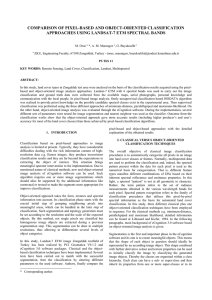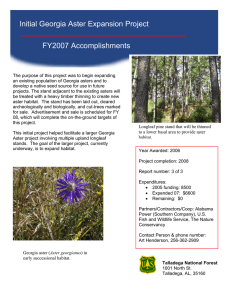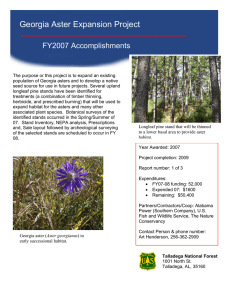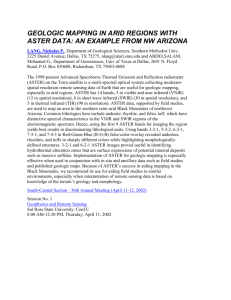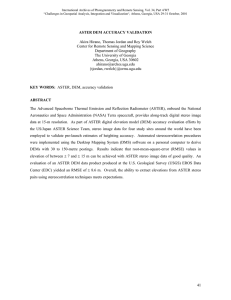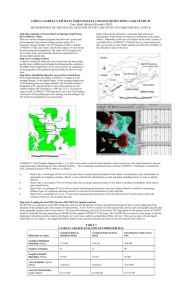ANALYSIS OF OBJECT-ORIENTED CLASSIFICATION RESULTS DERIVED FROM
advertisement
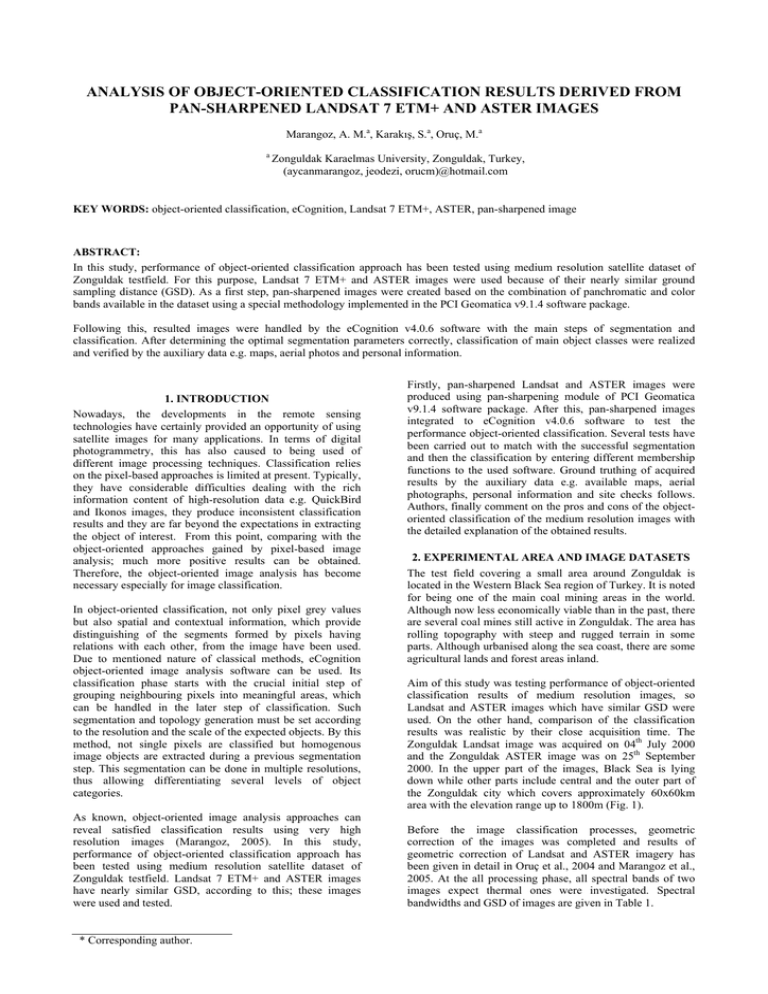
ANALYSIS OF OBJECT-ORIENTED CLASSIFICATION RESULTS DERIVED FROM PAN-SHARPENED LANDSAT 7 ETM+ AND ASTER IMAGES Marangoz, A. M.a, Karakış, S.a, Oruç, M.a a Zonguldak Karaelmas University, Zonguldak, Turkey, (aycanmarangoz, jeodezi, orucm)@hotmail.com KEY WORDS: object-oriented classification, eCognition, Landsat 7 ETM+, ASTER, pan-sharpened image ABSTRACT: In this study, performance of object-oriented classification approach has been tested using medium resolution satellite dataset of Zonguldak testfield. For this purpose, Landsat 7 ETM+ and ASTER images were used because of their nearly similar ground sampling distance (GSD). As a first step, pan-sharpened images were created based on the combination of panchromatic and color bands available in the dataset using a special methodology implemented in the PCI Geomatica v9.1.4 software package. Following this, resulted images were handled by the eCognition v4.0.6 software with the main steps of segmentation and classification. After determining the optimal segmentation parameters correctly, classification of main object classes were realized and verified by the auxiliary data e.g. maps, aerial photos and personal information. 1. INTRODUCTION Nowadays, the developments in the remote sensing technologies have certainly provided an opportunity of using satellite images for many applications. In terms of digital photogrammetry, this has also caused to being used of different image processing techniques. Classification relies on the pixel-based approaches is limited at present. Typically, they have considerable difficulties dealing with the rich information content of high-resolution data e.g. QuickBird and Ikonos images, they produce inconsistent classification results and they are far beyond the expectations in extracting the object of interest. From this point, comparing with the object-oriented approaches gained by pixel-based image analysis; much more positive results can be obtained. Therefore, the object-oriented image analysis has become necessary especially for image classification. In object-oriented classification, not only pixel grey values but also spatial and contextual information, which provide distinguishing of the segments formed by pixels having relations with each other, from the image have been used. Due to mentioned nature of classical methods, eCognition object-oriented image analysis software can be used. Its classification phase starts with the crucial initial step of grouping neighbouring pixels into meaningful areas, which can be handled in the later step of classification. Such segmentation and topology generation must be set according to the resolution and the scale of the expected objects. By this method, not single pixels are classified but homogenous image objects are extracted during a previous segmentation step. This segmentation can be done in multiple resolutions, thus allowing differentiating several levels of object categories. As known, object-oriented image analysis approaches can reveal satisfied classification results using very high resolution images (Marangoz, 2005). In this study, performance of object-oriented classification approach has been tested using medium resolution satellite dataset of Zonguldak testfield. Landsat 7 ETM+ and ASTER images have nearly similar GSD, according to this; these images were used and tested. * Corresponding author. Firstly, pan-sharpened Landsat and ASTER images were produced using pan-sharpening module of PCI Geomatica v9.1.4 software package. After this, pan-sharpened images integrated to eCognition v4.0.6 software to test the performance object-oriented classification. Several tests have been carried out to match with the successful segmentation and then the classification by entering different membership functions to the used software. Ground truthing of acquired results by the auxiliary data e.g. available maps, aerial photographs, personal information and site checks follows. Authors, finally comment on the pros and cons of the objectoriented classification of the medium resolution images with the detailed explanation of the obtained results. 2. EXPERIMENTAL AREA AND IMAGE DATASETS The test field covering a small area around Zonguldak is located in the Western Black Sea region of Turkey. It is noted for being one of the main coal mining areas in the world. Although now less economically viable than in the past, there are several coal mines still active in Zonguldak. The area has rolling topography with steep and rugged terrain in some parts. Although urbanised along the sea coast, there are some agricultural lands and forest areas inland. Aim of this study was testing performance of object-oriented classification results of medium resolution images, so Landsat and ASTER images which have similar GSD were used. On the other hand, comparison of the classification results was realistic by their close acquisition time. The Zonguldak Landsat image was acquired on 04th July 2000 and the Zonguldak ASTER image was on 25th September 2000. In the upper part of the images, Black Sea is lying down while other parts include central and the outer part of the Zonguldak city which covers approximately 60x60km area with the elevation range up to 1800m (Fig. 1). Before the image classification processes, geometric correction of the images was completed and results of geometric correction of Landsat and ASTER imagery has been given in detail in Oruç et al., 2004 and Marangoz et al., 2005. At the all processing phase, all spectral bands of two images expect thermal ones were investigated. Spectral bandwidths and GSD of images are given in Table 1. Landsat7 ETM+ image ASTER image Fig.1: Used images of Zonguldak testfield Sensor ETM+ Band 1: Band 2: Band 3: Band 4: Band 5: Band 6: Band 7: Pan: Spectral Bandwidths 0.45-0.52 µm (visible blue) 0.53-0.61 µm (visible green) 0.63-0.69 µm (visible red) 0.78-0.90 µm (VNIR) 1.55-1.75 µm (SWIR) 10.40-12.50 µm (thermal IR) 2.09-2.35 µm (SWIR) 0.52-0.90 µm GSD Sensor 30m 60m 30m 15m Table 1: Spectral bandwidths and GSD of Landsat 7 ETM+ and ASTER images Before analysing of images with eCognition object-oriented image analysis software, the images were enhanced by applying a pan-sharpening method used in PCI software. This method makes them possible to benefit from the sensors spectral capabilities simultaneously with its higher spatial resolution. 3. OBJECT-ORIENTED CLASSSIFICATION In this study, image segmentation and object-oriented classification phase were derived by using eCognition v 4.0.6 software. This software offers a relatively segmentation technique called Multiresolution Segmentation (MS). Because of the MS is a bottom-up region-merging technique; it is regarded as a region-based algorithm. MS starts by considering each pixel as a separate object. Subsequently, pairs of image objects are merged to form bigger segments (Darwish et al., 2003). The merging decision is based on local homogeneity criterion, describing the similarity between adjacent image objects. The pair of image objects with the smallest increase in the defined criterion is merged. The process terminates ASTER Band 1: Band 2: Band 3: Band 4: Band 5: Band 6: Band 7: Band 8: Band 9: Band 10: Band 11: Band 12: Band 13: Band 14: Spectral Bandwidths 0.52-0.60 µm (visible blue) 0.63-0.69 µm (visible green) 0.76-0.86 µm (visible red) 1.60 -1.70 µm (SWIR) 2.145 -2.185 µm (SWIR) 2.185-2.225 µm (SWIR) 2.235-2.285 µm (SWIR) 2.295-2.365 µm (SWIR) 2.360-2.430 µm (SWIR) 8.125-8.475 µm (thermal IR) 8.475-8.825 µm (thermal IR) 8.925-9.275 µm (thermal IR) 10.25-10.95 µm (thermal IR) 10.95-1165 µm (thermal IR) GSD 15m 30m 90m when the smallest increase of homogeneity exceeds a userdefined threshold (the so called Scale Parameter – SP). Therefore a higher SP will allow more merging and consequently bigger objects, and vice versa. The homogeneity criterion is a combination of color (spectral values) and shape properties (shape splits up in smoothness and compactness). Applying different SPs and color/shape combinations, the user is able to create a hierarchical network of image objects. (eCognition User Guide 4, 2004). Image segmentation phase is followed by the classification of the images. eCognition software offers two basic classifiers: a nearest neighbour classifier and fuzzy membership functions. Both act as class descriptors. While the nearest neighbour classifier describes the classes to detect by sample objects for each class which the user has to determine, fuzzy membership functions describe intervals of feature characteristics wherein the objects do belong to a certain class or not by a certain degree. Thereby each feature offered by eCognition can be used either to describe fuzzy membership functions or to determine the feature space for the nearest neighbour classifier. A class then is described by combining one or more class descriptors by means of fuzzy-logic operators or by means of inheritance or a combination of both. As the class hierarchy should reflect the image content with respect to scale the creation of level classes is very useful. These classes represent the generated levels derived from the image segmentation and are simply described by formulating their belonging to a certain level. Classes which only occur within these levels inherit this property from the level classes. This technique usually helps to clearly structure the class hierarchy (Marangoz et al., 2004). 4. SEGMENTATION AND CLASSIFICATION RESULTS The first step of the analysis is to identify image objects. This is done by using the MS approach as implemented in the software package eCognition (Baatz et al., 2000). By this software, object-oriented segmentations of the both images were tried using different segmentation parameters and spectral bands, because the quality of segmentation is decisive for outcome of subsequent classification (see Table 2 and Table 3). 2 3 4 5 6 1,5,6 1,5,6 1,4,5,6 1,4,5,6 1,4,5,6 Segm. mode 10 20 30 40 5 40 0.6 0.4 1.0 0 Nor. 0.8 0.2 0.7 0.3 Nor. 0.9 0.1 0.6 0.4 Nor. 0.8 0.2 0.5 0.5 Nor. Spectral Difference 1 1,2,3 Spectral Difference Level Bands Scale parameter Color Shape Compactness Smoothness Landsat 7 ETM+ image ASTER image Level 1 Level 1 Level 2 Level 2 Level 3 Level 3 Table 2: Segmentation parameters used for pan-sharpened Landsat 7 ETM+ image. Level Bands Scale parameter Color Shape Compactness Smoothness Segmentation mode 1 1,2,3 10 0.6 0.4 1.0 0 Normal 2 1,6,9 20 0.8 0.2 0.7 0.3 Normal 3 1,6,9 30 0.9 0.1 0.6 0.4 Normal Table 3: Segmentation parameters used for pan-sharpened ASTER image. Fig. 2: Results segmentations of subset of both images using different segmentation parameters. As can be realized that the smaller scale decreases the dimensionality and dividing the object into the sub-groups, while the larger scale combines the multi-segments into one (Fig. 2). From the acquired levels, most suitable one, the segmentation of the level 5 has been selected for the classification phase of Landsat image. In the same way, level 3 has been selected for ASTER image. Based on the properties of each spectral band, object-oriented segments have been analysed with different parameters in the related classes. As a result, the prominent segments are grouped and located in the corresponding classes. Then, classification procedure is completed by assigning the relevant class colour to segments and classified images are represented in Fig. 3. Level 4 Level 5 Level 6 Landsat7 ETM+ image ASTER image Fig. 3: Results of object-oriented classification of both pan-sharpened images. In Zonguldak testfield, as mentioned above, urbanized central part and Ereğli district are lying along of the Black Sea coast. The other urbanized districts are located inner part of the area. There are some large and small lakes mixed together. Furthermore, there is Filyos River which lies from Köroğlu Mountain - Çankırı and reaches to the Black Sea at Filyos district. Zonguldak city is famous with coal mining in Turkey, in some parts, there are several coal mines and accumulation areas of coal waste in the parts of the coast. There are also agricultural, open forested and dense forested areas inner regions. Considering the information about land cover classes above, at the classification phase, it was decided to perform the classification with a division into 10 land cover classes for the study area of Landsat image and 7 land cover classes of ASTER image (see Fig. 3). Object-oriented classification of urbanized part of Zonguldak testfield using Landsat and ASTER images are given in Fig. 4 and Fig. 5. Fig. 4: Object-oriented classification result of subset of pan-sharpened Landsat7 ETM+ image. 10 classes from Landsat and 7 classes from ASTER were identified because spectral bands of Landsat are dominant than spectral bands of ASTER based on bandwidths. As seen in Fig. 4 and Fig.5, some features could not be extracted, as the same time some features could not be classified correctly in classification of ASTER image according to classification of Landsat image. Looking at Fig. 4 and Fig. 5, it was seen that, some areas which classified as urban forest in ASTER classification actually belong to forest class. This situation can be seen on the right-top corner of the figures. This result was confirmed by high resolution images. On the other hand, water features like sea, lake and river can be extracted using infrared bands of each images. However, separating of these features from each other could only be derived from Landsat image by using visible bands of this image. Dam lake can be seen at the right-bottom corner of figures which could be separated from water class in Landsat and which could not in ASTER. Fig. 5: Object-oriented classification result of subset of pan-sharpened ASTER image. 5. ACCURACY ASSESSMENT OF THE CLASSIFICATION RESULTS Classification accuracy in remote sensing is to determine the agreement between the selected reference materials and the classified data. For this purpose, lots of sample segments in the testfield have been selected randomly from each image and their agreement with ground truth has been analysed. Then, error matrix has been generated by eCognition software and given in Table 4 and Table 5. These tables include not only the producer’s and the user’s accuracy values are given but also the kappa statistics are mentioned. Class Name Water Urban areas Dense forest Open area Forest Urban with forest Open forest Producer's Accuracy % 100 100 100 71 80 User's Accuracy % 100 92 100 45 100 Kappa Statistic 83 71 0.82 57 100 0.53 1.00 1.00 1.00 0.68 0.79 Water Urban areas Dense forest Open area Forest Urban with forest Open forest Kappa Statistic 0.92 0.73 0.75 0.43 0.37 Finally, based on the authors’s experience, it can be said that object-oriented classification approaches of medium resolution images can be used but, furthermore the efficiency of visible spectral bands should not be disregarded. 44 0.54 7. REFERENCES 64 0.59 Producer's Accuracy % 93 77 81 47 44 User's Accuracy % 100 87 78 56 52 60 64 Table 5: Accuracy results for classified ASTER image from object-oriented image analysis. Looking at the Table 4 and Table 5, classification results of Landsat are better than ASTER. We can see that in Table 4, open area and open forest classes have low accuracy cause of their similarity to each other. However in Table 5, most classes have low accuracy. This situation could be occurred by correlation of spectral bands to each other. At the end of classification analysis, accuracy statistics which includes overall accuracy and Kappa statistic for each image was given by eCognition software (Table 6). Accuracy Statistics Overall Accuracy (%) Overall Kappa Statistic 6. CONCLUSIONS In this paper, capacity of object-oriented classification approach to identify land cover was tested from pansharpened Landsat 7 ETM+ and ASTER images of Zonguldak testfield. For this purpose, eCognition objectoriented image analysis software was used for the classification of each image. In this software, two different projects were opened and firstly object-oriented segments were produced carefully and located in the relevant classes by fuzzy membership functions. After this, classifications were resulted one by one. Ground truthing of the acquired results by the available maps, aerial photographs and site checks were made by selecting random samples from each images. Detailed accuracy results were obtained as error matrixes and they shows that classification of pan-sharpened Landsat image produced more accurate results versus ASTER image. Based on the implementation of analysis of Landsat 7 project, it was seen that, urbanized, open and agricultural areas were identified easily. The sea and dam lake classes were separated from each other; furthermore the river could not be identified entirely. On the other hand, in the ASTER project, water and forest areas were identified with lower accuracy than other project. However, the river was extracted more accurately. Table 4: Accuracy results for classified Landsat 7 ETM+ image from object-oriented image analysis. Class Name similarly, the classification of Landsat produced more accurate results. As mentioned above, cause of correlation between spectral bands of ASTER, the overall accuracy and kappa values of Landsat are much better than ASTER. Landsat 7 ETM+ ASTER 83.7 70.2 0.808 0.647 Baatz, M., and A. Schäpe, A., 2000: Multiresolution Segmentation – an optimisation approach for high quality multi-scale image Segmentation, AGIT Symposium, Salzburg Darwish A, K Leukert, Reinhart W., 2003: Image Segmentation for the Purpose of Object-Based Classification, Proceedings of IGARSS 2003 IEEE, Toulouse eCognition, 2004: User Guide 4, Definiens Imaging GmbH, Munich Lewinski, S., 2005: Land use Classification of ASTER Image – Legionowo Test Site, 25th EARSel Symposium, Porto Marangoz, A.M., Büyüksalih, G., Büyüksalih, İ., Sefercik, U.G., Akçın, H., 2005: Geometric Evaluation, Automated DEM and Orthoimage Generation from Along-Track Stereo ASTER Images, 2nd International Conference on Recent Advances in Space Technologies Space in the Service of Society - RAST 2005, Istanbul Marangoz, A.M., Oruç, M., Büyüksalih, G., 2004: Object-oriented Image Analysis and Semantic Network for Extracting the Roads and Buildings From Ikonos Pan-sharpened Images, ISPRS XXth Congress, Istanbul Table 6: Overall accuracy and Kappa values for object-oriented classification results of images Oruç, M., Marangoz, A.M., Büyüksalih, G., 2004: Comparison of Pixel-based and Object-oriented Classification Approaches Using LANDSAT-7 ETM Spectral Bands, ISPRS XXth Congress, Istanbul It was seen from the Table 6, object-oriented classification of Landsat produced more accurate results than ASTER’s. While overall accuracy of Landsat 7 was %84 for classification, it was only %70 for ASTER. For kappa values, Whiteside, T., W. Ahmad 2004: Object-oriented Classification of ASTER Imagery for Landcover Mapping In Monsoonal Northern Australia. 12th Australian Remote Sensing and Photogrammetric Conference, Fremantle, WA.
